连词while的用法归纳
- 格式:doc
- 大小:20.00 KB
- 文档页数:2
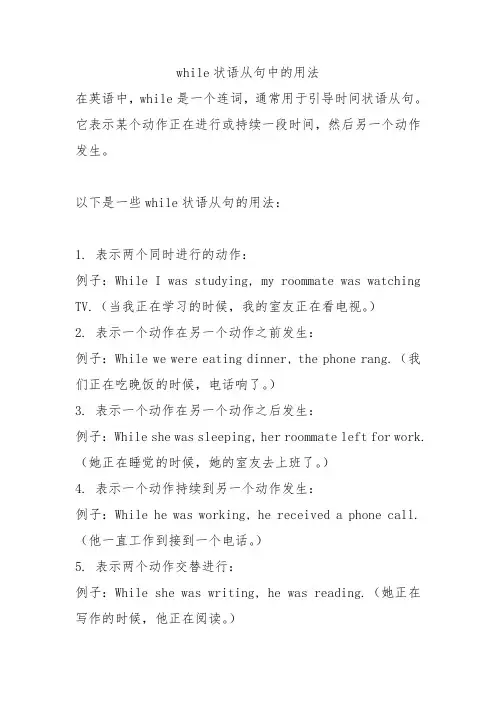
while状语从句中的用法
在英语中,while是一个连词,通常用于引导时间状语从句。
它表示某个动作正在进行或持续一段时间,然后另一个动作发生。
以下是一些while状语从句的用法:
1. 表示两个同时进行的动作:
例子:While I was studying, my roommate was watching TV.(当我正在学习的时候,我的室友正在看电视。
)
2. 表示一个动作在另一个动作之前发生:
例子:While we were eating dinner, the phone rang.(我们正在吃晚饭的时候,电话响了。
)
3. 表示一个动作在另一个动作之后发生:
例子:While she was sleeping, her roommate left for work.(她正在睡觉的时候,她的室友去上班了。
)
4. 表示一个动作持续到另一个动作发生:
例子:While he was working, he received a phone call.(他一直工作到接到一个电话。
)
5. 表示两个动作交替进行:
例子:While she was writing, he was reading.(她正在写作的时候,他正在阅读。
)。
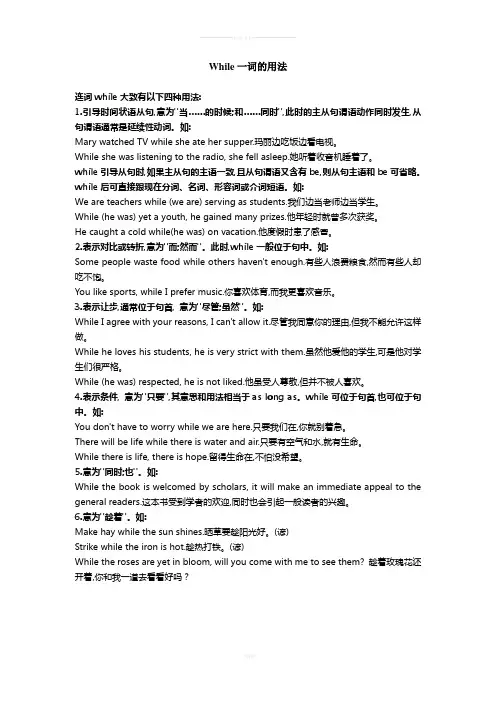
-------------精选文档-----------------While一词的用法连词while大致有以下四种用法:1.引导时间状语从句,意为"当……的时候;和……同时",此时的主从句谓语动作同时发生,从句谓语通常是延续性动词。
如:Mary watched TV while she ate her supper.玛丽边吃饭边看电视。
While she was listening to the radio, she fell asleep.她听着收音机睡着了。
while引导从句时,如果主从句的主语一致,且从句谓语又含有be,则从句主语和be可省略。
while后可直接跟现在分词、名词、形容词或介词短语。
如:We are teachers while (we are) serving as students.我们边当老师边当学生。
While (he was) yet a youth, he gained many prizes.他年轻时就曾多次获奖。
He caught a cold while(he was) on vacation.他度假时患了感冒。
2.表示对比或转折,意为"而;然而"。
此时,while一般位于句中。
如:Some people waste food while others haven't enough.有些人浪费粮食,然而有些人却吃不饱。
You like sports, while I prefer music.你喜欢体育,而我更喜欢音乐。
3.表示让步,通常位于句首, 意为"尽管;虽然"。
如:While I agree with your reasons, I can't allow it.尽管我同意你的理由,但我不能允许这样做。
While he loves his students, he is very strict with them.虽然他爱他的学生,可是他对学生们很严格。
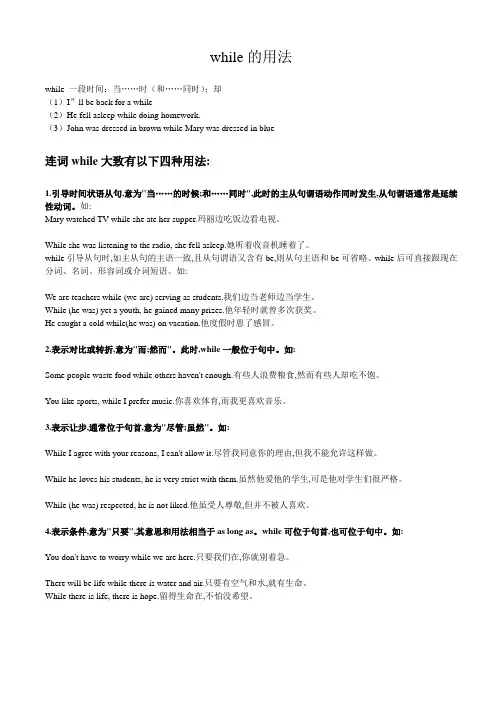
while的用法while 一段时间;当……时(和……同时);却(1)I”ll be back for a while(2)He fell asleep while doing homework.(3)John was dressed in brown while Mary was dressed in blue连词while大致有以下四种用法:1.引导时间状语从句,意为"当……的时候;和……同时",此时的主从句谓语动作同时发生,从句谓语通常是延续性动词。
如:Mary watched TV while she ate her supper.玛丽边吃饭边看电视。
While she was listening to the radio, she fell asleep.她听着收音机睡着了。
while引导从句时,如主从句的主语一致,且从句谓语又含有be,则从句主语和be可省略。
while后可直接跟现在分词、名词、形容词或介词短语。
如:We are teachers while (we are) serving as students.我们边当老师边当学生。
While (he was) yet a youth, he gained many prizes.他年轻时就曾多次获奖。
He caught a cold while(he was) on vacation.他度假时患了感冒。
2.表示对比或转折,意为"而;然而"。
此时,while一般位于句中。
如:Some people waste food while others haven't enough.有些人浪费粮食,然而有些人却吃不饱。
You like sports, while I prefer music.你喜欢体育,而我更喜欢音乐。
3.表示让步,通常位于句首,意为"尽管;虽然"。
如:While I agree with your reasons, I can't allow it.尽管我同意你的理由,但我不能允许这样做。
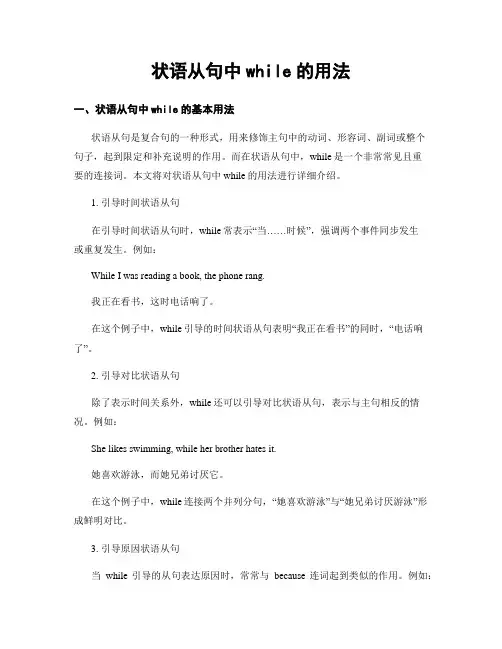
状语从句中while的用法一、状语从句中while的基本用法状语从句是复合句的一种形式,用来修饰主句中的动词、形容词、副词或整个句子,起到限定和补充说明的作用。
而在状语从句中,while是一个非常常见且重要的连接词。
本文将对状语从句中while的用法进行详细介绍。
1. 引导时间状语从句在引导时间状语从句时,while常表示“当……时候”,强调两个事件同步发生或重复发生。
例如:While I was reading a book, the phone rang.我正在看书,这时电话响了。
在这个例子中,while引导的时间状语从句表明“我正在看书”的同时,“电话响了”。
2. 引导对比状语从句除了表示时间关系外,while还可以引导对比状语从句,表示与主句相反的情况。
例如:She likes swimming, while her brother hates it.她喜欢游泳,而她兄弟讨厌它。
在这个例子中,while连接两个并列分句,“她喜欢游泳”与“她兄弟讨厌游泳”形成鲜明对比。
3. 引导原因状语从句当while引导的从句表达原因时,常常与because连词起到类似的作用。
例如:He refused to go to the party, while I went because all our friends were there.他拒绝去参加聚会,而我去了,因为我们所有的朋友都在那里。
其中,“他拒绝去参加聚会”是主句,while引导的状语从句“我去了”则是对这一决定做出原因解释。
二、状语从句中while的特殊运用除了基本用法外,状语从句中while还具有一些特殊的运用方式。
1. 引导让步状语从句在引导让步状语从句时,while可表示虽然或尽管。
例如:While it was raining heavily, they still decided to go hiking.尽管下着大雨,他们还是决定去远足。
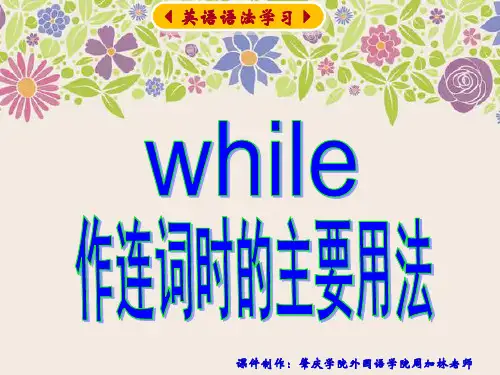
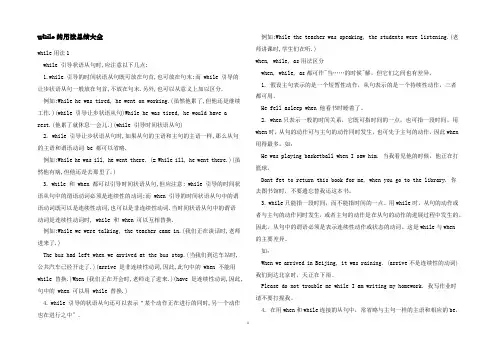
while的用法总结大全while用法1while 引导状语从句时,应注意以下几点:1.while 引导的时间状语从句既可放在句首,也可放在句末;而 while 引导的让步状语从句一般放在句首,不放在句末.另外,也可以从意义上加以区分.例如:While he was tired, he went on working.(虽然他累了,但他还是继续工作.)(while 引导让步状语从句)While he was tired, he would have a rest.(他累了就休息一会儿.)(while 引导时间状语从句)2. while 引导让步状语从句时,如果从句的主语和主句的主语一样,那么从句的主语和谓语动词 be 都可以省略.例如:While he was ill, he went there. (= While ill, he went there.)(虽然他有病,但他还是去那里了.)3. while 和 when 都可以引导时间状语从句,但应注意: while 引导的时间状语从句中的谓语动词必须是连续性的动词;而 when 引导的时间状语从句中的谓语动词既可以是连续性动词,也可以是非连续性动词.当时间状语从句中的谓语动词是连续性动词时, while 和 when 可以互相替换.例如:While we were talking, the teacher came in.(我们正在谈话时,老师进来了.)The bus had left when we arrived at the bus stop.(当我们到达车站时,公共汽车已经开走了.)(arrive 是非连续性动词,因此,此句中的 when 不能用while 替换.)When (我们正在开会时,老师走了进来.)(have 是连续性动词,因此,句中的 when 可以用 while 替换.)4. while 引导的状语从句还可以表示“某个动作正在进行的同时,另一个动作也在进行之中〞.例如:While the teacher was speaking, the students were listening.(老师讲课时,学生们在听.)when, while, as用法区分when, while, as都可作"当……的时候"解,但它们之间也有差异。
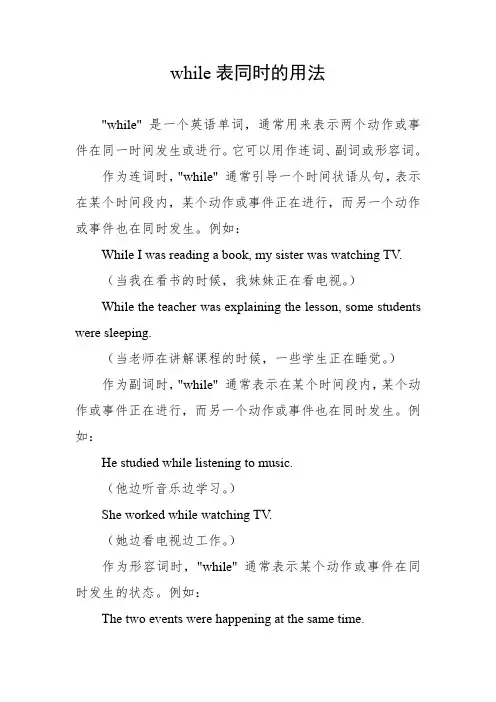
while表同时的用法"while" 是一个英语单词,通常用来表示两个动作或事件在同一时间发生或进行。
它可以用作连词、副词或形容词。
作为连词时,"while" 通常引导一个时间状语从句,表示在某个时间段内,某个动作或事件正在进行,而另一个动作或事件也在同时发生。
例如:While I was reading a book, my sister was watching TV.(当我在看书的时候,我妹妹正在看电视。
)While the teacher was explaining the lesson, some students were sleeping.(当老师在讲解课程的时候,一些学生正在睡觉。
)作为副词时,"while" 通常表示在某个时间段内,某个动作或事件正在进行,而另一个动作或事件也在同时发生。
例如:He studied while listening to music.(他边听音乐边学习。
)She worked while watching TV.(她边看电视边工作。
)作为形容词时,"while" 通常表示某个动作或事件在同时发生的状态。
例如:The two events were happening at the same time.(这两个事件同时发生。
)The concert was a while ago, but I still remember the music.(音乐会是很久以前的事情了,但我仍然记得那音乐。
)需要注意的是,"while" 通常用于表示两个或多个动作或事件在同一时间发生或进行,而不是同时发生。
在一些场合,"while" 也可以用于表示两个动作或事件交替进行的状态,例如:She worked while he napped.(她工作,他打盹。
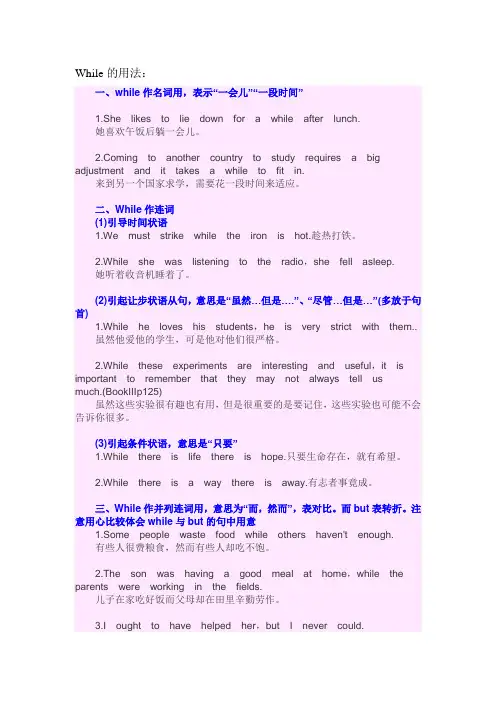
While的用法:一、while作名词用,表示“一会儿”“一段时间”1.She likes to lie down for a while after lunch.她喜欢午饭后躺一会儿。
ing to another country to study requires a big adjustment and it takes a while to fit in.来到另一个国家求学,需要花一段时间来适应。
二、While作连词(1)引导时间状语1.We must strike while the iron is hot.趁热打铁。
2.While she was listening to the radio,she fell asleep.她听着收音机睡着了。
(2)引起让步状语从句,意思是“虽然…但是….”、“尽管…但是…”(多放于句首)1.While he loves his students,he is very strict with them..虽然他爱他的学生,可是他对他们很严格。
2.While these experiments are interesting and useful,it is important to remember that they may not always tell us much.(BookIIIp125)虽然这些实验很有趣也有用,但是很重要的是要记住,这些实验也可能不会告诉你很多。
(3)引起条件状语,意思是“只要”1.While there is life there is hope.只要生命存在,就有希望。
2.While there is a way there is away.有志者事竟成。
三、While作并列连词用,意思为“而,然而”,表对比。
而but表转折。
注意用心比较体会while与but的句中用意1.Some people waste food while others haven't enough.有些人很费粮食,然而有些人却吃不饱。
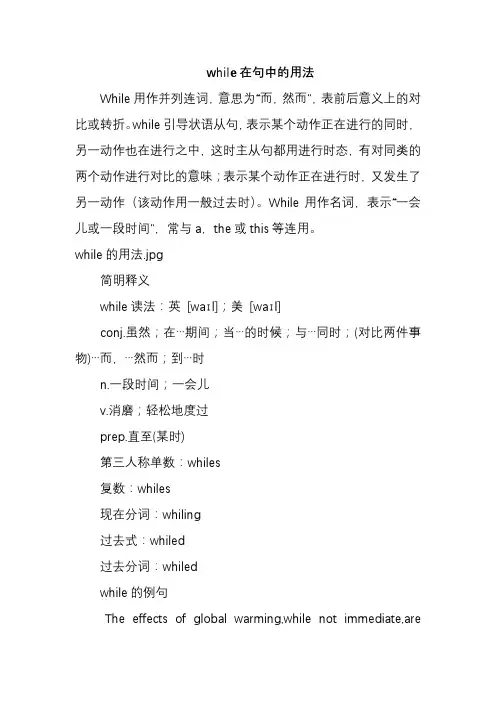
while在句中的用法While用作并列连词,意思为“而,然而”,表前后意义上的对比或转折。
while引导状语从句,表示某个动作正在进行的同时,另一动作也在进行之中,这时主从句都用进行时态,有对同类的两个动作进行对比的意味;表示某个动作正在进行时,又发生了另一动作(该动作用一般过去时)。
While用作名词,表示“一会儿或一段时间”,常与a,the或this等连用。
while的用法.jpg简明释义while读法:英[waɪl];美[waɪl]conj.虽然;在…期间;当…的时候;与…同时;(对比两件事物)…而,…然而;到…时n.一段时间;一会儿v.消磨;轻松地度过prep.直至(某时)第三人称单数:whiles复数:whiles现在分词:whiling过去式:whiled过去分词:whiledwhile的例句The effects of global warming,while not immediate,arepotentially catastrophic.全球气温上升的后果虽然并非即时发生,但可能潜伏着大灾难。
While her observations may be true about some men,they could hardly apply to the entire gender.虽然她的评论就某些男人而言可能是正确的,但绝不适用于所有男性。
It will take a while for the drug to work out of your system.这药得需要一段时间才能排出你的体外。
I'll be back in a little while.我一会儿就回来。
You'll water the plants while I'm away,won't you?我外出的时候请你给花草浇浇水,行不行?。
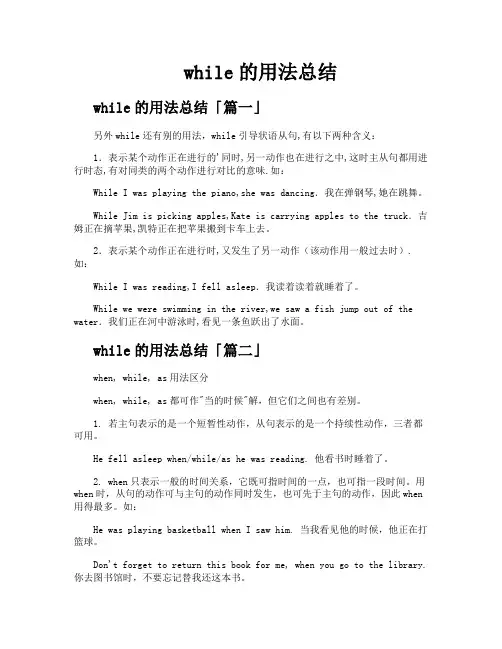
while的用法总结while的用法总结「篇一」另外while还有别的用法,while引导状语从句,有以下两种含义:1.表示某个动作正在进行的'同时,另一动作也在进行之中,这时主从句都用进行时态,有对同类的两个动作进行对比的意味.如:While I was playing the piano,she was dancing.我在弹钢琴,她在跳舞。
While Jim is picking apples,Kate is carrying apples to the truck.吉姆正在摘苹果,凯特正在把苹果搬到卡车上去。
2.表示某个动作正在进行时,又发生了另一动作(该动作用一般过去时).如:While I was reading,I fell asleep.我读着读着就睡着了。
While we were swimming in the river,we saw a fish jump out of the water.我们正在河中游泳时,看见一条鱼跃出了水面。
while的用法总结「篇二」when, while, as用法区分when, while, as都可作"当的时候"解,但它们之间也有差别。
1. 若主句表示的是一个短暂性动作,从句表示的是一个持续性动作,三者都可用。
He fell asleep when/while/as he was reading. 他看书时睡着了。
2. when只表示一般的时间关系,它既可指时间的一点,也可指一段时间。
用when时,从句的动作可与主句的动作同时发生,也可先于主句的动作,因此when 用得最多。
如:He was playing basketball when I saw him. 当我看见他的时候,他正在打篮球。
Don't forget to return this book for me, when you go to the library. 你去图书馆时,不要忘记替我还这本书。
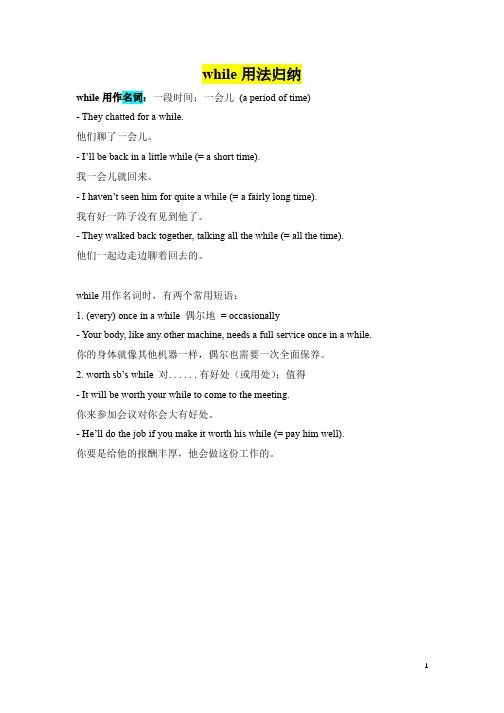
while用法归纳while用作名词:一段时间;一会儿 (a period of time)- They chatted for a while.他们聊了一会儿。
- I’ll be back in a little while (= a short time).我一会儿就回来。
- I haven’t seen him for quite a while (= a fairly long time).我有好一阵子没有见到他了。
- They walked back together, talking all the while (= all the time).他们一起边走边聊着回去的。
while用作名词时,有两个常用短语:1. (every) once in a while 偶尔地= occasionally- Your body, like any other machine, needs a full service once in a while. 你的身体就像其他机器一样,偶尔也需要一次全面保养。
2. worth sb’s while 对......有好处(或用处);值得- It will be worth your while to come to the meeting.你来参加会议对你会大有好处。
- He’ll do the job if you make it worth his while (= pay him well).你要是给他的报酬丰厚,他会做这份工作的。
while用作连词,引导从句:一、引导时间状语从句译作“当......时”。
例如:1. Make hay while the sun shines.趁着有太阳晒晒草。
2. We must work hard to gain more knowledge while we are young.趁着现在还年轻,我们必须刻苦学习,获得更多的知识。
while的用法
一while “当......时候”(此用法最常见),作从属连词引导时间状语从句,要求从句中的动词必须是连续性的,而其同义词when就没这种要求。
如:
Tom called on me while I was away.
I heard somebody knocking on the window while I was reading last night.
二while“而,却”,作并列连词连接表转折关系的并列句,相当于but,但含有对比的含义。
如:
He likes sports while his sister likes music.
My mother is cooking in the kitchen while my father is watching TV.
三while “虽然”,作从属连词引导让步状语从句,相当于although, 不倒装(though可倒装也可不倒装,但as必须倒装)。
如:
While he was not at home, he could guess what would happen in his family.
While a whale is like a fish, it isn't a fish at all.。
While的用法:一、while作名词用,表示“一会儿”“一段时间”1.She likes to lie down for a while after lunch.她喜欢午饭后躺一会儿。
ing to another country to study requires a big adjustment and it takes a while to fit in.来到另一个国家求学,需要花一段时间来适应。
二、While作连词(1)引导时间状语1.We must strike while the iron is hot.趁热打铁。
2.While she was listening to the radio,she fell asleep.她听着收音机睡着了。
(2)引起让步状语从句,意思是“虽然…但是….”、“尽管…但是…”(多放于句首)1.While he loves his students,he is very strict with them..虽然他爱他的学生,可是他对他们很严格。
2.While these experiments are interesting and useful,it is important to remember that they may not always tell us much.(BookIIIp125)虽然这些实验很有趣也有用,但是很重要的是要记住,这些实验也可能不会告诉你很多。
(3)引起条件状语,意思是“只要”1.While there is life there is hope.只要生命存在,就有希望。
2.While there is a way there is away.有志者事竟成。
三、While作并列连词用,意思为“而,然而”,表对比。
而but表转折。
注意用心比较体会while与but的句中用意1.Some people waste food while others haven't enough.有些人很费粮食,然而有些人却吃不饱。
while表同时的用法
【原创实用版】
目录
1.while 表同时的用法概述
2.while 表同时的用法举例
3.结论
正文
【1.while 表同时的用法概述】
在英语中,while 是一个多功能的连词,除了表示“当……的时候”,还可以表示两种情况同时存在。
当我们需要表达两种或多种情况同时发生时,可以使用 while 表同时的用法。
【2.while 表同时的用法举例】
下面我们通过一些例子来学习 while 表同时的用法:
例 1:I was studying while my sister was watching TV.(我一边学习,一边我妹妹在看电视。
)
在这个例子中,while 连接了两个同时发生的动作:我在学习,而我妹妹在看电视。
例 2:He is listening to the music while cooking dinner.(他一边做饭,一边听音乐。
)
这个例子中,while 表达了两个动作同时进行:他在做饭,同时听音乐。
例 3:She was working while her husband was sleeping.(她丈夫睡觉的时候,她在工作。
)
这个例子中,while 表示了两个动作在不同的时间段发生:她丈夫在
睡觉,而她在工作。
【3.结论】
总之,while 表同时的用法可以帮助我们清晰地表达两种或多种情况同时发生。
连词while的用法 连词while根据上下文有以下不同作用和含义。 一、引导时间状语从句 译作“当……时”。例如: 1. Make hay while the sun shines. 趁着有太阳晒晒草。(乘机行事,抓紧时机。) 2. We must work hard to gain more knowledge while we are young. 趁着现在还年轻,我们必须刻苦学习,获得更多的知识。 二、引导让步状语从句 常放在句首,译作“尽管”、“虽然”,比although或 though语气要轻。例如: 1. While I believe it is true, I cannot prove it. 虽然我相信那是真的,但我无法证明。 2. While any kind of athletic shoe can provide a certain amount of rebound, energy-return sneakers are designed to maximize this effect. 虽然任何一种运动鞋都能提供一定的反弹力,但回力运动鞋能够使这种效果最大化。 三、引导条件状语从句 相当于as long as,译作“只要”。例如: 1. While there is life, there is hope.有生命,就有希望。 2. While a spark of life remains, it is a doctor's duty to save the patient. 只要病人还有一息生机,医生就有责任挽救。 四、引导原因状语从句 相当于since,有“既然”的意思。例如: 1. You'll never save any money while you're so extravagant. 你这么奢侈,永远存不下钱来。 2. I'd like to get it settled today while we're at it. 既然我们着手干了,我想今天就把它干完。 五、连接并列句 表示对比,相当于whereas,译作“而”、“可是”。 例如: 1. An outdoors man will soon become pale if he changes to an indoor job, while a desk clerk will take on a tan after a short vacation in the sun. 从事室外工作的人如果调到室内工作,不久肤色就会变白;而一个伏案工作的文员出去度个短假,就会被太阳变黑。 2. Motion is absolute while stagnation is relative. 运动是绝对的,而静止是相对的。 六、连接并列句 表示递进,相当于and what is more, 译作“并且”、“而且”。例如: The new man-made fibres are more hardwearing than natural fibres and greatly reduce mending, while good ready-made clothes are cheap and plentiful. 新的人造纤维比天然纤维耐磨,因此能大大减少修补工作,而且做好的衣服价廉物美,数量也多。
while的用法_用法辨析while有当... 的时候;虽然;尽管;然而等意思。
while的用法:while的用法1:while用作连词时,表示在(过程)中,在期间。
常用来引导时间状语从句,当主句的主语和while所引导的从句的主语一致时, while从句中的主语、谓语往往可以省去。
while的用法2:while还可引导让步状语从句,意思是虽然,尽管,含有对比意味。
while的用法3:while表示对比关系时,意思是而,然而。
while的用法4:while还可用作及物动词,意思是消磨时间,常同副词away搭配。
while的常用短语:all the while一直,始终from begin to endHe teaches English in the school all the while. 他一直在这所学校里教英语。
once in a while时不时,偶尔,间或occasionallyHe went to see them once in a while. 他偶尔去探望他们。
while的用法例句:1. Mommy, you don’t need to stay while we talk.妈妈,我们谈话时你不必陪着.2. It took her a while to get acclimatized to her new surroundings.她花了一段时间才适应了新的环境。
3. Jim Coulters will mind the store while I’m away.我不在的时候吉姆库尔特斯会照看店铺的。
4. I’ll make the tea and you pop off for a while.我来备茶,你去歇一会儿吧。
5. Will you lend me your jacket for a little while?你能把上衣借给我穿一会儿吗?6. Argentina came to a virtual standstill while the game was being played.在比赛进行的时候,阿根廷全国几乎陷入了停顿状态。
一、考查表示时间的用法,其意为“当……的时候”。
如:We must strike while the iron is hot.我们要趁热打铁。
Stand still while I take your photograph.我给你拍照时站着不要动。
Have we got enough books to read while we are on holiday?假期里我们有足够的书看吗?Were there any calls for me while I was out?我出去的时候,有人来过电话吗?She hates anyone listening while she is telephoning.她打电话时不愿让任何人听。
二、考查表示让步的用法,其意为“尽管”“虽然”。
如:While the work was difficult, it was interesting.虽然工作有难度,但很有趣。
While I understand what you say, I can’t agree with you.虽然我理解你的意思,但我还是不同意。
While the Internet is of great help, I don’t think it’s a good idea to spend too much time on it.虽然因特网很有帮助,但我还是认为在其上花太多的时间不是个好主意。
While we don’t agree we continue to be friends.尽管我们意见不同,我们还是朋友。
While I did well in class, I was a poor performer at games.虽说我学习不错,我运动却不行。
While a few became richer, many did not.虽然一些人变得更富有了,但多数人并非如此。
三、考查表示对比的用法,其意为“而”“但”。
连词while除具有“当时”、“同时”等意义外,根据上下文还有以下不同含义及其不同译法。
一、引导时间状语从句
译作“当……时”。
例如:
1. Make hay while the sun shines.
趁着有太阳晒晒草。
(乘机行事,抓紧时机。
)
2. We must work hard to gain more knowledge while we are young.
趁着现在还年轻,我们必须刻苦学习,获得更多的知识。
二、引导让步状语从句
常放在句首,译作“尽管”、“虽然”,比although或 though语气要轻。
例如:
1. While I believe it is true, I cannot prove it.
虽然我相信那是真的,但我无法证明。
2. While any kind of athletic shoe can provide a certain amount of rebound,
energy-return sneakers are designed to maximize this effect.
虽然任何一种运动鞋都能提供一定的反弹力,但回力运动鞋能够使这种效果最大化。
三、引导条件状语从句
相当于as long as,译作“只要”。
例如:
1. While there is life, there is hope.
有生命,就有希望。
2. While a spark of life remains, it is a doctor's duty to save the patien t.
只要病人还有一息生机,医生就有责任挽救。
四、引导原因状语从句
相当于since,有“既然”的意思。
例如:
1. You'll never save any money while you're so extravagant.
你这么奢侈,永远存不下钱来。
2. I'd like to get it settled today while we're at it.
既然我们着手干了,我想今天就把它干完。
五、连接并列句
表示对比,相当于whereas,译作“而”、“可是”。
例如:
1. An outdoors man will soon become pale if he changes to an indoor job, wh ile a desk clerk will take on a tan after a short vacation in the sun.
从事室外工作的人如果调到室内工作,不久肤色就会变白;而一个伏案工作的文员出去度个短假,就会被太阳变黑。
2. Motion is absolute while stagnation is relative.
运动是绝对的,而静止是相对的。
六、连接并列句
表示递进,相当于and what is more, 译作“并且”、“而且”。
例如:
1. The new man-made fibres are more hardwearing than natural fibres and gre atly reduce mending, while good ready-made clothes are cheap and plentiful.
新的人造纤维比天然纤维耐磨,因此能大大减少修补工作,而且做好的衣服价廉物美,数量也多。
2. Of course, I resolutely determined not to marry, while I quite forgot to consider at all that great rock of disaster in the working-class world-- sickn ess.
当然, 我下定决心不结婚,而且把工人阶级的巨大灾难——疾病,也忘得一干二净。